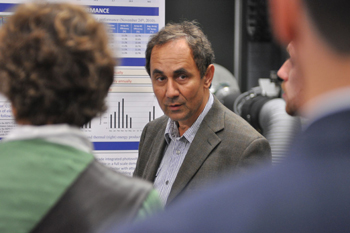Green engineering a draw for European journalists
On June 11, Concordia’s Faculty of Engineering and Computer Science hosted a dozen European journalists who have been touring Canadian green energy facilities.
The journalists visited the laboratories of professors Georgios Vatistas, Andreas Athienitis, Paul Fazio and doctoral candidate Diane Bastien and learned about some of the cutting-edge technologies that have the potential to reduce the use of non-renewable energy and to improve energy efficiency.
The journalists’ tour, organized by the Canadian Embassy in Paris, also included visits to facilities in Sherbrooke, Toronto and Vancouver.

Georgios Vatistas’s heat exchanger was the first stop in the Concordia visit after a greeting from Graham Carr, interim vice-president of Research and Graduate Studies, and Catherine Mulligan, associate dean of Engineering and Computer Science. First unveiled in February, the heat exchanger exploits decades of research into vortex flows, inspired by Vatistas’s childhood in Greece, where he saw first-hand the power of whirlpools in the sea.

The current-day innovation maximizes the unique capacity of swirling flows to increase heat transfer exchange, making the device 40 times more efficient than traditional models. Given that heat exchangers are already a staple in power plants, refrigeration systems and numerous other industrial environments, the worldwide potential of Vatistas’s research is extensive.
The journalists, representing publications such as Le Figaro in France, La Stampa in Italy, Wirtschafts Woche in Germany and The Engineer in the United Kingdom, subsequently visited the Solar Simulator and Environmental Chamber Lab. These facilities allow researchers to better learn how to harness solar power for use in buildings as well as to test how different infrastructure components stand up to varying climactic conditions.

Andreas Athienitis explained the long-term potential of solar energy, speculating that the new technology that allows for building-integrated photovoltaic/thermal facades, such as the one found on the John Molson School of Business Building, will represent an increasingly practical energy solution in the coming decades. Paul Fazio gave insights into the Environmental Chamber, which can be used to test building envelope components, such as advanced wall systems, under a range of conditions from Arctic cold to desert heat.
Related links:
• Faculty of Engineering and Computer Science
• Georgios Vatistas and the heat exchanger
• Solar Simulator-Environmental Chamber Lab